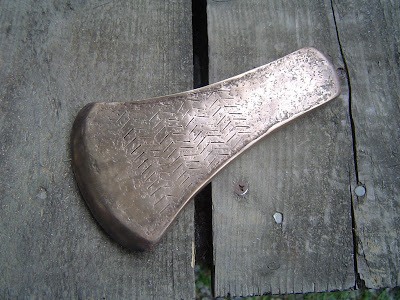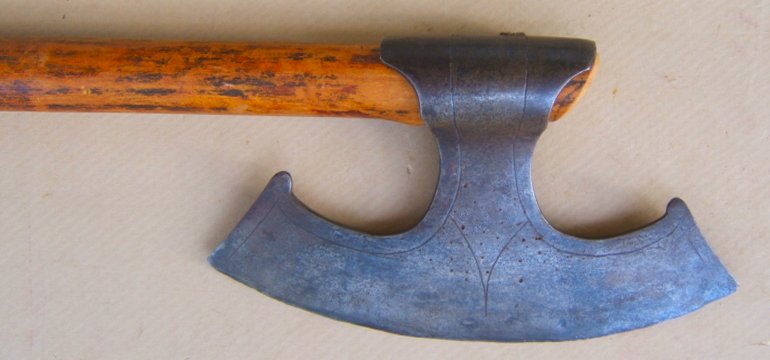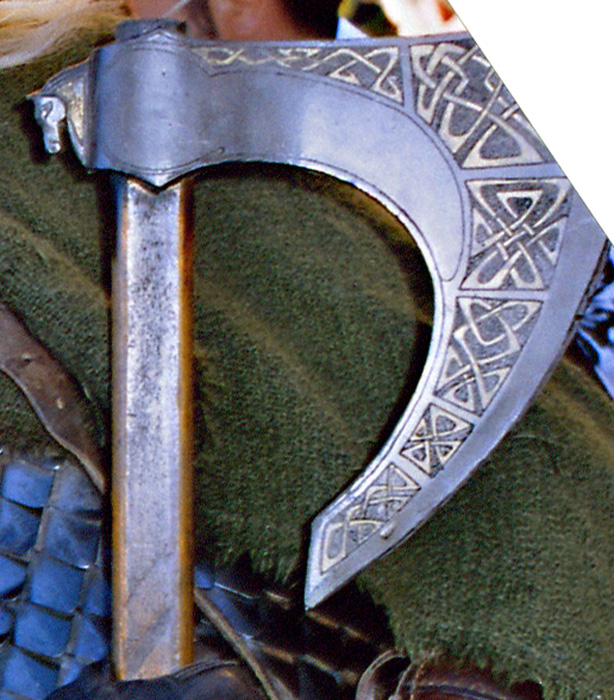- Home
- Forums
- Mount & Blade: Warband
- The Forge - Mod Development
- The Caravanserai - Released Mods
- Warband
- Brytenwalda [B]
You are using an out of date browser. It may not display this or other websites correctly.
You should upgrade or use an alternative browser.
You should upgrade or use an alternative browser.
pictures of historical accurate replicas needed (weapons, armors, etc.)
- Thread starter BrustwarzenLenny
- Start date
Users who are viewing this thread
Total: 2 (members: 0, guests: 2)
Elithirion
Recruit

On the leather armour
According to the research done by the reenactment society Regia Anglorum ((A group based mostly in the UK but has small groups else where. )) leather armour existed, certainly the techniques to make them exist.
Lamellar armour was exotic in europe but could have been available.
Leather Jacks, Cottes, Waistcoats , leather faced Gambesons, padded armour, helmets and backings for mail would be common, however Regia are still wary on leather limb armour but have not ruled it out. ((They take authenticity very seriously))
They agree that leather is not the best protection but similar to mail its made to stop glancing blows not stop a spear thrust, leather strength also varies on the way its used and prepared ((Hardened leather, thickness, layers ect.))
Regia is my most reliable source as they are my reenactment group, their authenticity regulations are very high.
Just my piece
According to the research done by the reenactment society Regia Anglorum ((A group based mostly in the UK but has small groups else where. )) leather armour existed, certainly the techniques to make them exist.
Lamellar armour was exotic in europe but could have been available.
Leather Jacks, Cottes, Waistcoats , leather faced Gambesons, padded armour, helmets and backings for mail would be common, however Regia are still wary on leather limb armour but have not ruled it out. ((They take authenticity very seriously))
They agree that leather is not the best protection but similar to mail its made to stop glancing blows not stop a spear thrust, leather strength also varies on the way its used and prepared ((Hardened leather, thickness, layers ect.))
Regia is my most reliable source as they are my reenactment group, their authenticity regulations are very high.
Just my piece
Elithirion
Recruit

Sorry for the double post but ive dragged up some images.

Scramseax where the common daggers of the time used commonly as a pocketknife, eating utensil and weapon of war, double edged daggers evolved at a later date. There are also a longer version called the Langseax.





Scramseax where the common daggers of the time used commonly as a pocketknife, eating utensil and weapon of war, double edged daggers evolved at a later date. There are also a longer version called the Langseax.




I think, my work on new objects will never end 
It's good to keep busy, Brust 
What I think would be best of all, in my own opinion, would be new textures for most (or some) of the existing armor. Both cloth and chainmail. Because we have these beautiful helmets which don't really match the armor you wear it with. That's a shame. Here's an example of what I mean:
 (And I know that 1.3 will have some nice new texture updates, I just don't know if these particular armors are part of it)
(And I know that 1.3 will have some nice new texture updates, I just don't know if these particular armors are part of it)
The chain mail on the armor just seems.. too new and bright, maybe? Again, just my opinion, but if I knew how I'd probably make the armor chainmail (and the gloves!) out of the same textures the helmet has. And some more cloth and leather textures maybe, because the armor deserves it

What I think would be best of all, in my own opinion, would be new textures for most (or some) of the existing armor. Both cloth and chainmail. Because we have these beautiful helmets which don't really match the armor you wear it with. That's a shame. Here's an example of what I mean:

The chain mail on the armor just seems.. too new and bright, maybe? Again, just my opinion, but if I knew how I'd probably make the armor chainmail (and the gloves!) out of the same textures the helmet has. And some more cloth and leather textures maybe, because the armor deserves it

olla podrida
Regular

Elithirion said:On the leather armour
According to the research done by the reenactment society Regia Anglorum ((A group based mostly in the UK but has small groups else where. )) leather armour existed, certainly the techniques to make them exist.
Lamellar armour was exotic in europe but could have been available.
Leather Jacks, Cottes, Waistcoats , leather faced Gambesons, padded armour, helmets and backings for mail would be common, however Regia are still wary on leather limb armour but have not ruled it out. ((They take authenticity very seriously))
They agree that leather is not the best protection but similar to mail its made to stop glancing blows not stop a spear thrust, leather strength also varies on the way its used and prepared ((Hardened leather, thickness, layers ect.))
Regia is my most reliable source as they are my reenactment group, their authenticity regulations are very high.
Just my piece
Hm, they were certainly able to make leather and used it for a multitude of things, but the only thing that I am aware of (taking my master degree in prehistoric archeology) which could pass as "leatherarmour" is a 5th century roman coat from Alexandria.

Can you dig out the reason why Regia Anglorum would judge leather armour historical correct?
I think that leather is probably not the best form of non metal armour, layered lor quilted linnen will work better.
The technique of making hardened leather was not used before the late 13th century as far as we know. And unhardened leather is simply thick conservated hide with approximatly the same armour value as living hide in the same thickness. You can cut or thrust through this easily.
The only organic material I know to be used as armour in the 7th century is horn. The helmet in the (principal) childs grave below the Cologne Cathedral was made of gilded copper spangen and horn panels over a "knitted" leather cap. (okay, there you got me. But here, leather wasn't used as primary armour

For the sake of the game, I would advice on rather improve and propagate the use of the shield instead of more medium class armour. It would be more accurate to have many people with only a tunic and maybe a phrygian cap or pilleus panonicus on and a big strong shield and a high skil to use it.
By the way, I like the lanceheads you posted. But isn't the last one a bit late? Afaik winged lances start to be used in the late 8th century in the Frankish Realm.
The seax is a bit odd though, with the steel fittings on the hilt. A seaxhilt should be whithout any metal fittings in this period.
Even extremely rich people had simple organic seaxhilts.
BTW:
I found a nice photo album with 7th century stuff and want to share it:
http://www.myspace.com/hagunaz/photos/albums/album/0?page=3
some more sword hilts this time more simple designs:

late 4th/early 5th century swordhilt from Nydam Mose, southern Denmark, made of horn. A quite ubiquitious design for organic hilts.
could look somehow like this one which I made some years ago for a blunt blade:

This is a hilt of horn made by Hector Cole in England:

It is more 7th centuryish, but still same basic design.
And here a more posh version, whith a Sutton Hoo pommelcap and fittings for the guards:

@ Waffenbaum: Yeah, this is true. Would be great if the textures could be adjusted some time later. If the busy people here have enough time
Spongly
Knight

olla podrida said:The seax is a bit odd though, with the steel fittings on the hilt. A seaxhilt should be whithout any metal fittings in this period.
Even extremely rich people had simple organic seaxhilts.
Oddly enough they've just found (and I mean last year - this is unpublished as yet) a 7th century Northumbrian Seax with bronze and silver hilt fittings at a burial at Loftus in Cleveland. I'll see if I can get any further info on the appearance and post back, but some seaxes could, it seems, be pretty elaborate weapons.
olla podrida
Regular

The question is when...
The seax of the Pouan burial f.e. has a leaf gilded hilt and the seaxes from Nydam oftenly have bromze fittings. But theeese are 5th century finds and a totally different topic (them beeing hunnic cavalry weapons). Even 6th or 7th century seaxes with elaborate hilts would not have anything like this steel fittings on them.
That's , my point. But if you have any new seax findings with pictures, I would be happy to see them. As would be the modders i presume
The seax of the Pouan burial f.e. has a leaf gilded hilt and the seaxes from Nydam oftenly have bromze fittings. But theeese are 5th century finds and a totally different topic (them beeing hunnic cavalry weapons). Even 6th or 7th century seaxes with elaborate hilts would not have anything like this steel fittings on them.
That's , my point. But if you have any new seax findings with pictures, I would be happy to see them. As would be the modders i presume
Skandinav said:No, no leather armor in the 10th and 11th century as far as sources go, either, that's only in the movies and fantasy games.
I don't want to be rude or anything, but is your opinion based on the lack of evidence? If so, then it's like saying that people of old didn't have any brains, because remains of brains haven't been found.
Leather decays quickly, it'll get brittle and will crumble even during the lifetime of the owner. Sure, it's not as effective, but the phrase "None at all" isn't exactly fitting; the better would be: "Not widely used" or at an extreme "Unlikely"(which may support a possibility).
Spongly
Knight

Tancred_de_Houdan said:Skandinav said:No, no leather armor in the 10th and 11th century as far as sources go, either, that's only in the movies and fantasy games.
I don't want to be rude or anything, but is your opinion based on the lack of evidence? If so, then it's like saying that people of old didn't have any brains, because remains of brains haven't been found.
Leather decays quickly, it'll get brittle and will crumble even during the lifetime of the owner. Sure, it's not as effective, but the phrase "None at all" isn't exactly fitting; the better would be: "Not widely used" or at an extreme "Unlikely"(which may support a possibility).
He did say "as far as sources go". And plenty of other leather goods like shoes have survived in Ireland and Denmark, but no leather armour. There's also no pictorial or written references to leather armour from this period.
So not effective, no one talks about it at the time, draws any warriors wearing it, and none has ever been found is about as definitive as you can get for the moment in what is a pretty obscure period.
olla podrida
Regular

@Tancred
Do you know how many leather fragments from the Medieval Age have been found? Litarally, tons of them.
Whether an object or traces of it remains in the soil over a longer period of time depends on the material of the object and the copmositin of the chemical substances in the soil.
Leather f.e. will not decay easily if the soil is acerbic and anaerobic. If these conditions are met over a long period of time, the leather object will remain more or less intact, even over thousands of years.
Examples are :
The "Ötzi" which was preserved in a glacier over 5300 Years.
http://en.wikipedia.org/wiki/%C3%96tzi_the_Iceman
Or the Bogsten man, and 14th centuy swede which fell into a bog and is remarkedly well preserved, like the Ötzi.
Or the skandinavian Bog finds like Thorsbjerg Mose, Nydam Mose and Illerup Mose, 2nd to 6th century weapon sacrifices of heathen Scandinavians which were considerate enough to deposit their offerings to their Victory God in the perfect chemical environment for us to excavate. Not only swords, lances, bows, arrows, javelins helmets, armours and shields have been found largely intact and whith their organic material but also clothing and personal belongings of the enemy warriors. At Illerup they discovered even the dead former propriators of the equipment. They had been sacrificed, too.
http://en.wikipedia.org/wiki/Thorsberg_moor
These ar only some of the more prominent well preserved organic finds in Europe. Actually the greater part of the organic finds espacially leather
has been found in lod well shafts and latrines in medieval town centres, in bogs and pagan graveyards. We have acually thousands of medieval shoes in our european museums and museum magazines.
But back to your point that we coudn't possibly know all of the stuff these people used by early medieval people.
There is this catchphrase: Absence of evidence is not nessecarily evidence of absence.
But honestly, we KNOW what these people had, what they wore and what they eat. A 150 years of ever more exact archeology has happened in Europe. Millions of finds have been excaveted and analysed and we roughly know most of their living circumstances now.
In comparison with the other leather finds made, the pieces whitch belonged to leather clothing are extremely few. And those where mostly rain colthing. As stated above, I do not know of one piece of identifyable leather armour.
The other point you mentioned, that leather armour would be practical has been discussed too oftenly for me to have any interest in starting yet an other one. Look at the different fora like myarmoury (http://www.myarmoury.com/talk/) or roman army talk (http://www.romanarmytalk.com/rat/viewforum.php?f=17) and so on.
Leather simply doesn't have the capacity to bee a good armour on its own. It was only used as a backing material for the real protective material like in coats of plate and scale armours.
@ Spongly You've said it in a nutshell!
Do you know how many leather fragments from the Medieval Age have been found? Litarally, tons of them.
Whether an object or traces of it remains in the soil over a longer period of time depends on the material of the object and the copmositin of the chemical substances in the soil.
Leather f.e. will not decay easily if the soil is acerbic and anaerobic. If these conditions are met over a long period of time, the leather object will remain more or less intact, even over thousands of years.
Examples are :
The "Ötzi" which was preserved in a glacier over 5300 Years.
http://en.wikipedia.org/wiki/%C3%96tzi_the_Iceman
Or the Bogsten man, and 14th centuy swede which fell into a bog and is remarkedly well preserved, like the Ötzi.
Or the skandinavian Bog finds like Thorsbjerg Mose, Nydam Mose and Illerup Mose, 2nd to 6th century weapon sacrifices of heathen Scandinavians which were considerate enough to deposit their offerings to their Victory God in the perfect chemical environment for us to excavate. Not only swords, lances, bows, arrows, javelins helmets, armours and shields have been found largely intact and whith their organic material but also clothing and personal belongings of the enemy warriors. At Illerup they discovered even the dead former propriators of the equipment. They had been sacrificed, too.
http://en.wikipedia.org/wiki/Thorsberg_moor
These ar only some of the more prominent well preserved organic finds in Europe. Actually the greater part of the organic finds espacially leather
has been found in lod well shafts and latrines in medieval town centres, in bogs and pagan graveyards. We have acually thousands of medieval shoes in our european museums and museum magazines.
But back to your point that we coudn't possibly know all of the stuff these people used by early medieval people.
There is this catchphrase: Absence of evidence is not nessecarily evidence of absence.
But honestly, we KNOW what these people had, what they wore and what they eat. A 150 years of ever more exact archeology has happened in Europe. Millions of finds have been excaveted and analysed and we roughly know most of their living circumstances now.
In comparison with the other leather finds made, the pieces whitch belonged to leather clothing are extremely few. And those where mostly rain colthing. As stated above, I do not know of one piece of identifyable leather armour.
The other point you mentioned, that leather armour would be practical has been discussed too oftenly for me to have any interest in starting yet an other one. Look at the different fora like myarmoury (http://www.myarmoury.com/talk/) or roman army talk (http://www.romanarmytalk.com/rat/viewforum.php?f=17) and so on.
Leather simply doesn't have the capacity to bee a good armour on its own. It was only used as a backing material for the real protective material like in coats of plate and scale armours.
@ Spongly You've said it in a nutshell!
Spongly
Knight

I should say that it would be nice to see some "subarmalis" type armour in this setting - perhaps quilted linen jacks in a vaguely Roman style.
As for the seax, it'll be a while before there are pictures - the conservators are still working on x-raying and cleaning it up, but it looks like a beautiful weapon. The burial at Loftus is quite possibly royal - at least the main burial is a woman in a bed burial with some really impressive jewellery, including re-used iron-age British coins which have been punched through so they can be strung as a necklace. The seax comes from another grave on the site, and if I remember rightly was found with a jadeite whetstone.
As for the seax, it'll be a while before there are pictures - the conservators are still working on x-raying and cleaning it up, but it looks like a beautiful weapon. The burial at Loftus is quite possibly royal - at least the main burial is a woman in a bed burial with some really impressive jewellery, including re-used iron-age British coins which have been punched through so they can be strung as a necklace. The seax comes from another grave on the site, and if I remember rightly was found with a jadeite whetstone.
olla podrida said:@Tancred
Thanks! I shall learn from this
olla podrida
Regular

@ Spongly
Yeah, but the problem here is that the subarmalis can only be extrapolated from written sources and so the exact appearence of thuch a garment is not clear.
My best guess would be a linnen lined felt vest of some kind, maybe with short sleeves. I would avoid pteruges, though. I think they lost their protectiv value when the linothorax wasn't used anymore and remained a classicistical ornament on the armours of higher ranking roman soldiers. Maybe common in the east and italy, but not so much in the north. Original roman textile armour also wouldn't survive the two hundred years from their depature from britain to the Timeline of the mod.
Can you tell me more about the location of the burial you wrote about? I guess you mean Loftus in Yorkshire, UK, not in Cleveland, US?
I didn't know that there is a Cleveland in England, too.
The jadeit whetstone is interesting. Could it be a touchstone?
@Tancred
Your welcome! Good thing for you, it is better to make mistakes and learn something from them then not to fail and learn nothing.
Yeah, but the problem here is that the subarmalis can only be extrapolated from written sources and so the exact appearence of thuch a garment is not clear.
My best guess would be a linnen lined felt vest of some kind, maybe with short sleeves. I would avoid pteruges, though. I think they lost their protectiv value when the linothorax wasn't used anymore and remained a classicistical ornament on the armours of higher ranking roman soldiers. Maybe common in the east and italy, but not so much in the north. Original roman textile armour also wouldn't survive the two hundred years from their depature from britain to the Timeline of the mod.
Can you tell me more about the location of the burial you wrote about? I guess you mean Loftus in Yorkshire, UK, not in Cleveland, US?
I didn't know that there is a Cleveland in England, too.
The jadeit whetstone is interesting. Could it be a touchstone?
@Tancred
Your welcome! Good thing for you, it is better to make mistakes and learn something from them then not to fail and learn nothing.
Spongly
Knight

olla podrida said:@ Spongly
Yeah, but the problem here is that the subarmalis can only be extrapolated from written sources and so the exact appearence of thuch a garment is not clear.
My best guess would be a linnen lined felt vest of some kind, maybe with short sleeves. I would avoid pteruges, though. I think they lost their protectiv value when the linothorax wasn't used anymore and remained a classicistical ornament on the armours of higher ranking roman soldiers. Maybe common in the east and italy, but not so much in the north. Original roman textile armour also wouldn't survive the two hundred years from their depature from britain to the Timeline of the mod.
Can you tell me more about the location of the burial you wrote about? I guess you mean Loftus in Yorkshire, UK, not in Cleveland, US?
I didn't know that there is a Cleveland in England, too.
The jadeit whetstone is interesting. Could it be a touchstone?
@Tancred
Your welcome! Good thing for you, it is better to make mistakes and learn something from them then not to fail and learn nothing.
I guess the gambeson model in the game at the moment is perhaps close to a subarmalis anyway. Though the Sutton Hoo treasure would perhaps imply that there was some attempt made by insular kings to look Roman - the Northumbrian kings were supposed to have carried a Roman style banner called a thufa ahead of them.
The burial is in Loftus which is right on the edge of Yorkshire. The original Cleveland is indeed in England - Cliffland if you're feeling all Anglo-Saxon. It's down the coast from Redcar and Hartlepool, pretty much in the middle of the Kingdom of Northumbria. Lots of Kentish style goods in the graves, date early to mid 7th century.
Not sure quite what you mean by touchstone. It's a long jadeite stone, similar shape to the Sutton Hoo whetstone without the elaborate endpieces, with no sign of ever having been used to sharpen anything, so probably ceremonial.
Here's a link to a few online photos of some of the objects that were cleaned up last year...
http://www.teesarchaeology.com/new/StreetHouseGallery.html
There are a lot of historical information in this thread. I am reading it pleased. Thanks you!
olla podrida
Regular

"Touchstone" is the english term for a small slate of stone which is used to assay the alloy of precious gold and silver items.
http://en.wikipedia.org/wiki/Touchstone_%28assaying_tool%29
As i read that the whetstone was made out of jadeit, it's clear that it could't be used efficiantly for sharpening knives, the mineral doesn't have a grain structure which is nessecary for this.
For assaying precious metal, you would only need a clean polished monochrome stone surface harder than the metals. But I guess if this certain stone would have been used for it, traces of gold and silver would have been found.
Thank you for the link. Very interesting!
@ idibil: De nada. But I fear that we get carried away from the topic of the thread sometimes. Although I guess it does no harm to discuss these aspects of early medieval archeology, it helps people understand how we can gather solid information about a prehistoric period of time.
http://en.wikipedia.org/wiki/Touchstone_%28assaying_tool%29
As i read that the whetstone was made out of jadeit, it's clear that it could't be used efficiantly for sharpening knives, the mineral doesn't have a grain structure which is nessecary for this.
For assaying precious metal, you would only need a clean polished monochrome stone surface harder than the metals. But I guess if this certain stone would have been used for it, traces of gold and silver would have been found.
Thank you for the link. Very interesting!
@ idibil: De nada. But I fear that we get carried away from the topic of the thread sometimes. Although I guess it does no harm to discuss these aspects of early medieval archeology, it helps people understand how we can gather solid information about a prehistoric period of time.
olla podrida
Regular

Some nice things, but the finish is to rough for our period. They could make a very fine polished finish for their weapons and they didn't like this rough from the hammer look, it would have ment poor workmanship to them.
Besides, they work better when they are polished; they cut more easily through things and don't rust as easily as nonpolished items.
Most of the things are not in the mods period. But the first picture is a very nice late neolithic bronze axe, I never made such a beautiful one!
PS: The last one is nice, where is it from?
Besides, they work better when they are polished; they cut more easily through things and don't rust as easily as nonpolished items.
Most of the things are not in the mods period. But the first picture is a very nice late neolithic bronze axe, I never made such a beautiful one!
PS: The last one is nice, where is it from?
Similar threads
- Replies
- 2
- Views
- 175
- Replies
- 21
- Views
- 824





















